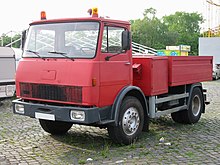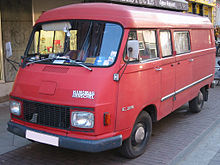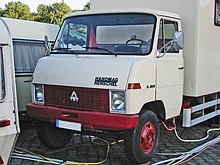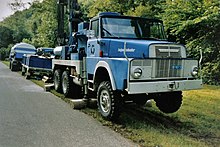Hanomag-Henschel
The Hanomag Henschel Fahrzeugwerke GmbH (short: HHF ) was a truck manufacturer based in Hanover , through a merger of the traditional German truck manufacturer in 1969 Hanomag and Henschel was born. After Daimler-Benz AG took over all the shares in HHF , the Hanomag-Henschel brand disappeared from the market in 1974, and individual Hanomag-Henschel models continued to be built under the Mercedes-Benz brand until 1978 .
history


Creation of the company
The mechanical engineering and vehicle manufacturer Hanomag (from Hanover , truck production since 1905) was taken over by Rheinische Stahlwerke AG in 1952 , the locomotive and truck manufacturer Henschel (from Kassel , truck production since 1925) followed in 1964 , 1965 the Tempo- Factory in Hamburg, the vans produced. The product range of Hanomag also included construction machinery and tractors and light to medium trucks , while the Henschel works , locomotives and medium had to heavier lorries in the program.
However, Rheinstahl saw its commercial vehicle production at Hanomag and Henschel only as a sideline activity, which was expressed, for example, in the fact that the two sub-companies Hanomag and Henschel, although their products complemented each other ideally, were not combined immediately after the takeover of Henschel. As a result of the general steel crisis in Germany at the end of the 1960s, Rheinstahl urgently needed money and therefore started looking for a financially strong partner from the commercial vehicle industry who would participate in the truck divisions of the two companies Hanomag and Henschel and possibly take over them. Rheinstahl therefore initially started negotiations with Magirus-Deutz (which failed) and later with British Leyland . The negotiations with Leyland drew the attention of Daimler-Benz AG , which saw the British as serious competition. To prevent Leyland from gaining a foothold on the German market, Daimler-Benz also negotiated with Rheinstahl and was successful.
On April 1, 1969, Rheinstahl spun off the commercial vehicle divisions from the two companies Hanomag and Henschel and merged them into the newly founded Hanomag-Henschel-Fahrzeugwerke GmbH based in Hanover . Daimler-Benz participated with 51%. In addition, Daimler-Benz took a 25% stake in the remaining Rheinstahl Hanomag. Since then, the otherwise unchanged production of vehicles from the manufacturers Hanomag and Henschel have been given the new company logo " Hanomag-Henschel ". The Hanomag-Henschel plants were located in Hanover ( Linden-Süd and Ricklingen ) (Hanomag's main plant, supplied engines for the Hanomag-Henschel vehicles), Hamburg-Harburg (former Tempo plant , had been taken over by Hanomag), Bremen - Sebaldsbrück (former Borgward plant , had been taken over by Hanomag) and Kassel-Nord-Holland (main plant of Henschel).
While there was a certain “division of labor” in the German truck industry up until then (companies such as Borgward , Opel and Hanomag manufactured vans and light to medium-weight trucks, companies such as MAN , Büssing , Magirus-Deutz and Henschel produced medium to heavy trucks) The merger of Hanomag and Henschel to form Hanomag-Henschel made it the first “full-range supplier” to offer a full range of commercial vehicles from light vans ( Harburger Transporter ) to medium-weight models and 26-tonne trucks for long-distance transport.
The quick end of the new brand
Further financial problems at Rheinstahl meant that at the end of 1970 the company also sold the remaining shares in Hanomag-Henschel for DM 140 million to Daimler-Benz AG. In return, Daimler-Benz returned its stake in Hanomag to Rheinstahl.
As it soon turned out, this trade actually signified the beginning of the end of the brand names Hanomag and Henschel or the recently founded joint venture in the commercial vehicle industry . Although Daimler-Benz promised to keep Hanomag-Henschel as a second sales channel (i.e. as an independent brand alongside its parent brand Mercedes-Benz ), it was not particularly consistent in this regard: First, the heavy Hanomag-Henschel trucks gradually switched to Mercedes technology changed over, although at that time a new generation of engines at Hanomag-Henschel was ready for the market, and its production then gradually stopped. If the Hanomag-Henschel vehicles were able to fill the gaps in the existing Mercedes-Benz program, they continued to be produced for a while. For a transitional period, several models were sold in parallel both under the previous name Hanomag-Henschel and under the Mercedes-Benz brand. This was especially true for the light Harburg transporters from Hanomag, which were built (most recently exclusively as Mercedes) until 1978 (and thus were the last remnants of Hanomag-Henschel) as well as for the heavy construction vehicles from the Henschel range. These were given a grace period because they enjoyed a very good reputation with customers and because Mercedes-Benz was still rather weak in this area at the time (there were no forward-control vehicles with all-wheel drive there ). During the transition period, as with the Harburger Transporter, construction vehicles originally developed by Henschel were even offered with the Mercedes star and Mercedes type designation.
After the model change of heavy vehicles at Mercedes-Benz from 1973 this gap in the program was closed. As a result, the last vehicles bearing the Hanomag-Henschel brand name disappeared from the market in 1974. Rheinstahl-Hanomag sold the engine production remaining in Hanover-Linden to Volvo . The systems were dismantled in 1973 and brought to Sweden. In 1978 Hanomag-Henschel-Fahrzeugwerke GmbH was also incorporated by name into Daimler-Benz AG. Mercedes-Benz trucks were produced in the former Henschel truck factory in Kassel until 1980. Since then, only axles for commercial vehicles from Daimler-Benz, now trading under the name of Daimler AG , as well as commercial vehicle cardan shafts and differential gears for passenger cars from the Daimler Group have been built there.
Vehicles produced
The vehicles built and offered by Hanomag-Henschel were essentially the same types that had previously been available from the individual brands Hanomag and Henschel. A total of around 230,000 vehicles were manufactured by Hanomag-Henschel between 1969 and 1975. Specifically, these were the following models:
Harburg transporter
The Harburger Transporter was a vehicle in the light payload range, the main features of which were designed by the Tempo brand, which was taken over by Hanomag , specifically the Tempo Matador model , which was launched in 1963. In 1967 the Tempo Matador underwent a visual makeover and from then on offered under the brand name Hanomag and the model names F 20, F 25, F 30 and F 35. From 1969 the brand name on the vehicles was Hanomag-Henschel. The vehicle continued to be built by Daimler-Benz even after Hanomag-Henschel ended, until 1978.
F series
The light to medium-weight trucks of the so-called F-series from Hanomag-Henschel had a short-hooded design and came from Hanomag. They came onto the market there in 1967 with completely redesigned cab designs by Louis Lucien Lepoix . At Hanomag-Henschel they rolled off the production line with the type designations F 45, F 46, F 55, F 65, F 66, F 75, F 76 and F 86 and were continued Hanomag models. Its production in Bremen-Sebaldsbrück was discontinued after only six years of production in 1973, although this series sold very successfully. The Austrian truck manufacturer Steyr took over the construction with slight retouching on the front in its own commercial vehicle program and continued to build the vehicles for a while.
Mercedes-Benz T2
The T2 , a large transporter or light truck made by Mercedes-Benz, was also available under the name Hanomag-Henschel from 1971 to 1974 with modified headlights and a different radiator grille than usual at Mercedes-Benz. The vehicles were manufactured by Daimler-Benz in the Düsseldorf plant; the type designations were F 40, F 46, F 55 and F 65 as a truck and F 40 B, F 45 B and F 45-O B as a minibus.
Medium-duty trucks
The medium-duty trucks from Hanomag-Henschel with a modern forward-control cab were originally developed for Hanomag, but then "moved" within the Rhine Steel Group and brought 1969 as Henschel on the market. In the same year the brand name of the vehicles changed to Hanomag-Henschel. These types, which closed the gap between the previous model range from Hanomag and that of Henschel, were built until 1974, they were even delivered until the following year 1975. This means that these types are the last vehicles to be named Hanomag -Henschel were sold.
Heavy front control vehicles and hoods
The heavy trucks from Hanomag-Henschel were available as forward control and classic long-nosed trucks . These were in each case continuations of Henschel prototypes, both of which appeared on the market in 1961 and were built in a kind of modular system from largely identical parts.
Forward control
In 1969 and 1971 there were slight facelifts on the front control (smoother front and wider radiator grille, but these measures were not taken consistently, in some cases the original and the modified models were on the market at the same time). After Hanomag-Henschel was taken over by Daimler-Benz, there was a quick changeover to Mercedes-Benz technology, initially only under the sheet metal, for example in the form of Mercedes-Benz engines. Later, the forward control vehicles were "officially" converted to the Mercedes-Benz brand and were available with a Mercedes star on the radiator grille and Mercedes-Benz model names. Production of these types both as Hanomag-Henschel and Mercedes-Benz ceased in 1974.
Hood
The Hauber from Henschel were continued almost unchanged from 1969 by Hanomag-Henschel and also taken off the market in 1974.
More pictures
See also
literature
- Horst-Dieter Görg (Ed.): Hanomag trucks . Delius Klasing Verlag, Bielefeld 2006, ISBN 3-7688-1824-1
Web links
- hanomag-museum.de
- ( Page no longer available , search in web archives: information on Hanomag-Henschel trucks )
- Photos of Hanomag Henschel trucks
- Hanomag-Henschel page from the Netherlands, z. Partly with German texts
- Henschel HS 12 HAK ( Memento from November 1, 2010 in the Internet Archive ) Hanomag website of the pre-glowing IG Engelschoff










